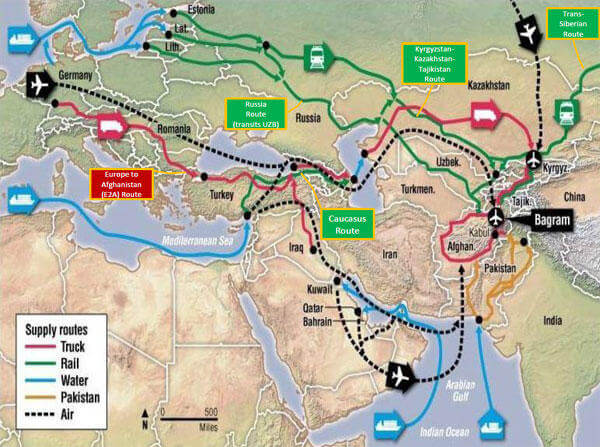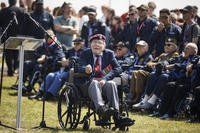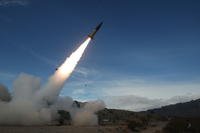Lingering beneath the radar due to ongoing clamor regarding Syria, the Afghan drawdown effort continues to remove personnel and equipment from the war-ravaged country by relying on a diverse network of transportation means and supply routes, U.S. military officials said.
Overall, the U.S. military is making progress with the ongoing removal or transport of up to $30 billion worth of equipment currently in Afghanistan, Maj. Gen. Aundre Piggee, Director for Logistics and Engineering, CentCom, told Military.com in an interview. As the decade-plus long war in Afghanistan continues to wind down, at least 1.4 million individual pieces of equipment still need to be removed, he said.
"We are on a glide path based on the plan of where we need to be, working to ensure that we have all of the equipment out and align it with the personnel reductions. We have closed more than 600 [Forward Operating Bases]," he said. "We are on a path to meet the presidential directive to get our personnel and equipment out by the timeline he has given us."
The particular size and nature of U.S. military future operations in Afghanistan are still very much being determined, Piggee said, explaining that the logistical footprint beyond 2014 is still being discussed. The U.S.-Afghan bi-lateral security agreements are close to being finalized and that the result will likely influence the size and scope of any potential future mission, he said.
Even after 2014, planning continues by U.S. leaders to support the NATO mission in Afghanistan dubbed Resolute Support. Deputy Commander for U.S. Forces-Afghanistan Lt. Gen. Mark Milley told reporters that U.S. and NATO military leaders are considering the size and scope of the mission and what equipment and resources it might need.
U.S. Central Command, U.S. Transportation Command and other elements of the U.S. military are moving along with a $5 to $7 billion effort to remove the equipment which remains in Afghanistan. This includes closing FOBs and removing the whole range of military gear from small arms to larger platforms such as wheeled and tracked vehicles, Piggee explained.
 |
Piggee said it can take up to three years to restore all the war-damaged equipment, an effort which can cost up to $10 billion. However, buying the equipment all over again would cost at least $18 billion, so the drawdown effort can result in savings, Piggee added.
However, some equipment will get handed over to the Afghan National Army.
Equipment can be flown out of the country, driven to ports and put on ships for transport, or in some cases moved to pre-positioned storage locations. In addition, cargo can be driven along a variety of routes. These include a south-westward route through Pakistan to Karachi or other southern ports. There is also a route called the Northern Distribution Network which winds through northern Afghanistan and parts of central Asia.
The Northern Distribution Network, or NDN, hinges upon a series of carefully crafted agreements with participating countries, Piggee explained.
"Those agreements have been in place for quite some time. We did a lot of work early on to form those agreements. We continue to build those relationships. We use those routes for various commodities as we bring supplies in and out of Afghanistan. It crosses through some of the former Soviet Union countries," he added.
The NDN, which is also used by U.S. coalition partners, traverses through the Czech Republic, Slovakia, Hungary, Romania, the Black Sea, Georgia, Azerbaijan, Kazakhstan, Uzbekistan, Kyrgyzstan and Tajikistan.
The strategically vital Northern Distribution Network took on added significance in 2011 when the Pakistani supply route was shut down for a period of time due to tensions between NATO and Pakistani authorities regarding a NATO airstrike.
The Northern Distribution Network currently accounts for only about 5-percent of the supplies currently leaving Afghanistan, Piggee said.
In addition, Piggee described what's called multi-modal operations where equipment is driven or flown to a port location wherein it is placed on a ship for transport. The U.S. military uses ports in the United Arab Emirates and Azerbaijan, among other locations.
Piggee said the drawdown effort is more difficult for a land-locked country such as Afghanistan, saying lessons were learned from the Iraq drawdown.
"Afghanistan is not Iraq. We do not have a Kuwait where we can roll everything in, stage it and then determine what to do" he explained.
As for shipping equipment out of Afghanistan, Piggee said the U.S. recently resolved an issue with the Afghan government which was asking for additional fees from the U.S.
"The government of Afghanistan wanted to charge an additional fee or tax for crossing their borders. We worked with their government and we think we have that issue ironed out. That is no longer an issue and we have freedom of movement," Piggee said.


























